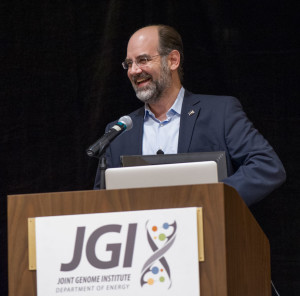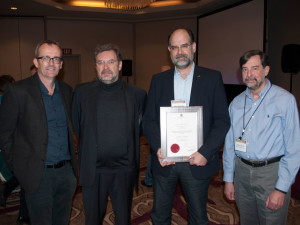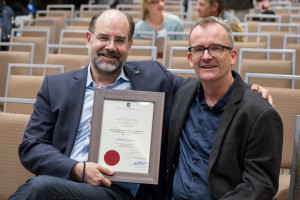
DOE JGI Prokaryote Super Program Head Nikos Kyrpides
At the recent 10th Annual Genomics of Energy & Environment meeting hosted by the U.S. Department of Energy Joint Genome Institute (DOE JGI), a DOE Office of Science User Facility, Nikos Kyrpides, head of the DOE JGI Prokaryote Super Program, received the Van Niel International Prize in Bacterial Systematics. The Van Niel Prize was established in 1986 in honor of microbiologist Cornelis Van Niel’s contribution to scholarship in the field of microbiology, and is awarded every three years by the University of Queensland in Australia on the recommendation of a panel of experts of the International Committee on Systematics of Prokaryotes. Phil Hugenholtz, Director of the Center for Ecogenomics at the University of Queensland and a former DOE JGI colleague of Kyrpides, was on hand at the Meeting to present the award.
An example of Kyrpides’ efforts to systematically describe and classify microbes in action can be seen in the Integrated Microbial Genomes (IMG) data management system that his program developed and maintains in partnership with the Biosciences Computing Group of Berkeley Lab’s Computational Research Division. IMG is the leading data analysis system of the DOE JGI’s Prokaryote Super Program, and Kyrpides has been pushing the developments as the scientific lead of the project from its first working prototype in 2005 to its current incarnation. On the IMG system’s 10-year anniversary, he took time to reflect on the milestones achieved thus far and future directions.
What are the highlights of the last 10 years to you?
In a period of 10 years, IMG has broken several records and has been established as one of the premier data management systems in the community for comparative analysis of microbial genomes and metagenomes. Its data size has grown 70-fold in terms of number of data sets and 22,000-fold in number of genes. We have currently almost 50,000 genomes in our system, containing 90 million genes. It’s taken 20 years to sequence all of those genomes; I anticipate we will easily double that number in the next two years. We have 6,000 metagenome data sets, which contain 29 billion genes. As far as I know, this represents the largest publicly available database of metagenomics genes and therefore this is one more of IMG’s records. We’ve grown from a few hundred to about 12,000 registered users in more than 90 countries. We provide an alternative source of data, particularly for metagenomes, and we add significant value through the integration of various data types, as well as with curation and annotation.
In terms of data integration, we’ve managed to integrate several different data types including one of the largest collections of curated metadata from the GOLD database, as well as several omics types including transcriptomics, metatranscriptomics, proteomics, and methylomics. In an effort to connect to our DNA synthesis program at the JGI, we have integrated a large collection of known natural products and connected them to their biosynthetic gene clusters, creating one of the largest resources in the field. We are currently working towards the integration of metabolomics and transposomics data produced at the JGI. Adding all of these means a completely different operation from the straightforward comparison of genes and genomes. With transcriptomes, for example, you’re now talking about the expression of genes you already have, and expression levels vary under varying conditions. In transposomics, you look at the genes that are essential or have different fitness under varying conditions. So the original IMG’s three-dimensional model of genes, genomes and functions has become more multidimensional as you add each of the different data types.
What do you think has helped IMG grow over the past 10 years?
One of the critical things is that it was a joint development between a group of engineers under the leadership of Victor Markowitz, with long experience in genomic data, and a group of biologists that had very strong genomics and bioinformatics backgrounds. Biologists provided the requirements on how the data analysis tools and workflows should be organized, and the developers implemented exactly what the biologists wanted. It’s clear there was a grand vision upfront to handle this much growth in the past 10 years. However, there is always a difference between knowing the path and walking the path. In our case, I believe we did both. We can continue another 10 years on this current system, although we also need to start exploring new solutions for more efficient handling of the data deluge ahead.
One more of our early choices that I believed proved to be critical both for the growth and the success of the system was to offer only a single data processing option for all datasets submitted into our system. We do the annotation for the users, and we process the datasets the way we know best. Maintaining a huge system such as IMG gives you great power, and with great power comes great responsibility. I believe we’re obliged to figure out and apply the best annotation practice at any time rather than allowing users to figure out what to use and which one choose as some other systems do. Providing an environment where all the data are uniformly processed and annotated is of paramount value and importance.

(Left to Right:) Microbial ecologist and director of the University of Queensland Australian Centre for Ecogenomics Phil Hugenholtz, German microbiologist Hans-Peter Klenk, 2011-2014 Van Niel awardee Nikos Kyrpides and 2008-2011 Van Niel awardee George Garrity.
Looking forward to the next 10 years, what are some of the challenges the IMG system will need to tackle?
Our data sets are thousands of terabytes in size and we’ll be going to petabytes soon. We need to scale at the level of hundreds of thousands of data sets and hundred of billions of genes. Right now our user interface can support the comparison of a few hundred datasets but what we need and what researchers are asking for is to compare thousands against thousands. No one is doing something like that now. Everyone is currently comparing a metagenome against isolate genomes, but no system can efficiently provide a comparison of a metagenome against other metagenomes. Given the size of the data involved, that would take weeks and you can’t do this efficiently on a production scale (i.e. on a weekly basis) even with high performance computing (HPC) right now.
The National Energy Research Scientific Computing Center (NERSC) is a vital partner in succeeding in the era of big data. We’re already operating at the scale where processing of our data requires a HPC environment and we are very fortunate that at the JGI this is provided by NERSC. We need a bigger database and bigger computer clusters to support the growing community demand, but we also need to have the right computational environment to run our pipelines.
Another big challenge is how to support big data, without sacrificing data quality. For example, annotating the metadata in the Genomes OnLine Database (GOLD) is heavily manual, but it adds tremendous value to the sequence data. Manual annotation certainly contradicts with scaling, but the availability of metadata is critical information in order to interpret the data we have.
How do you see IMG integrating with KBase? What are the challenges here?
The two systems have different scientific goals and overall mission and because of that they also have fundamentally different design commitments, and follow different principles in data organization and user support. For example, while IMG’s focus is on the comparative analysis of microbial genomes and metagenomes with emphasis on the interface between the two, the focus of the Department of Energy Systems Biology Knowledgebase (KBase) seems to be more on the isolate genome side and metabolic modeling at least for now. Moreover, while one of IMG’s strengths lies in the state-of-the-art data processing pipelines integrated into the system, enabling uniform annotation (and therefore comparability) across all of its datasets, KBase is following a different principle, allowing users to select across various available annotation pipelines. Due to the above, system integration doesn’t seem to be the right path here. Our primary goal instead is to enable users to review and analyze their data as well as move easily across the two systems. In order to achieve that we need to develop a seamless data transfer/exchange between JGI and KBase and this is currently the direction of our joint efforts.
What do you hope IMG will look like and be able to do for users in 10 years?

Former JGIer Phil Hugenholtz (right), now at the University of Queensland Center for Ecogenomics, presented the Van Niel Prize to Nikos Kyrpides (left).
The exponential growth of sequence data fueled from the democratization of genome sequencing is having already a dramatic effect on the available solutions in data management, including integrating, storing, and processing of the data as well as enabling their analysis and distribution to the community. Some of the most frequently adopted solutions improvise on “cutting corners” with detrimental effects on the quality and precision of the results. Practitioners of these types of approaches invariably select data partitioning instead of integration, and speed over accuracy, thus severely inflating the ramifications of the “streetlight effect” in data interpretation.
My hope for the next 10 years is that IMG will persevere with its current course in supporting the JGI user community and JGI Science through its emphasis on high quality, and will maintain its position as a premier comparative analysis system for microbial genomes and metagenomes, worldwide. To achieve that, IMG will need to remain strongly coupled to the constantly evolving JGI’s scientific directions and technology developments, particularly in the area of functional genomics, and at the same time continue providing unique solutions for data integration and visualization.
In terms of new directions, my expectation is that in the next decade, the biggest overhaul in the landscape of microbial genomics and metagenomics will be at the interface of the two, and therefore this is where a large part of future IMG developments will focus. In keeping with its goal of supporting the analysis of both the parts and the whole, I would like to see IMG playing a central role in enabling the identification and analysis of individual populations from environmental communities, as well as facilitating the elucidation of their role within the community.
What should the user community know about IMG as the data management system embarks on the next 10 years?
There’s a huge amount of functionality in IMG already, but we certainly need to continue adding more. The two main directions in the near future include adding more functionality and efficient supporting data/size growth. New functionality will include expanding the system to support the new data types produced from JGI functional genomics efforts (e.g. metabolomics and transposomics), but also creating specialized datamarts such as the IMG-ABC (integrating Natural Products and their corresponding Biosynthetic gene clusters)
We are also expanding our coverage of eukaryotic genomes to include more plant and fungal genomes into IMG. Our goal is to achieve a more holistic approach in data integration and analysis, in order to study complex biological systems, such as the plant microbiome. Of course, getting the large isolate genomes in the system will mean substantial increases in the comparison times and computational resources investments. But that’s the obvious way to go, you need to have all the data integrated. If you have missing parts, discovery is missed.